Inside: In part 1 of this 4-part series, you’ll learn how to turn daily kindergarten routines into rituals that build community and provide children with a sense of connection. Part 2 explores weekly rituals, part 3 monthly rituals and part 4 seasonal rituals.
Kindergarten Routines They Remember
Do you still play the name game? Is she going to learn the color word songs? Remember when we watched the eagle eggs hatch?
This is what a an older brother and former student asked when he brought his little sis to see her new classroom. I always find it fascinating to hear what they remember about their time in kindergarten. What I’ve discovered is that the things they remember most are not isolated activities, but rather part of classroom routines and rituals.
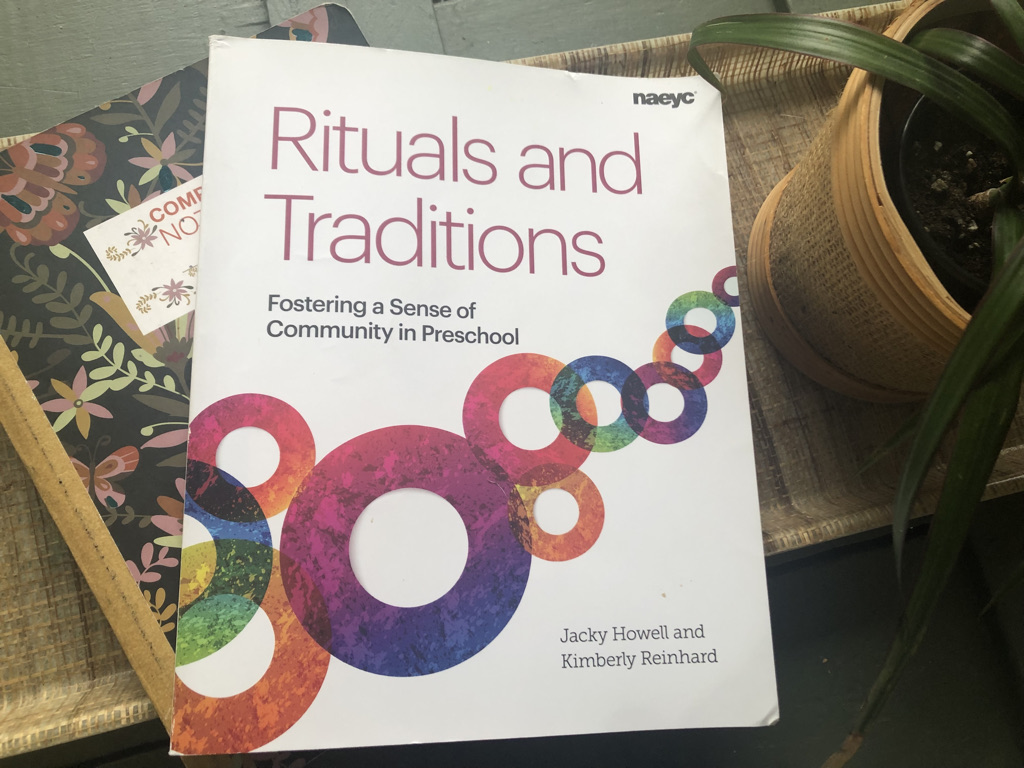
In their book, Rituals and Traditions, Jacky Howell and Kimberly Reinhard say, “In early childhood settings, the repetitive, cyclical and predictable nature of rituals and traditions makes everyday classroom events meaningful and reassuring to children. Routines make life feel orderly and knowable. Rituals take that feeling a step further.”
Kindergarten Routine or Ritual?
Each morning I make myself a cup of tea? Is that a routine or a ritual?
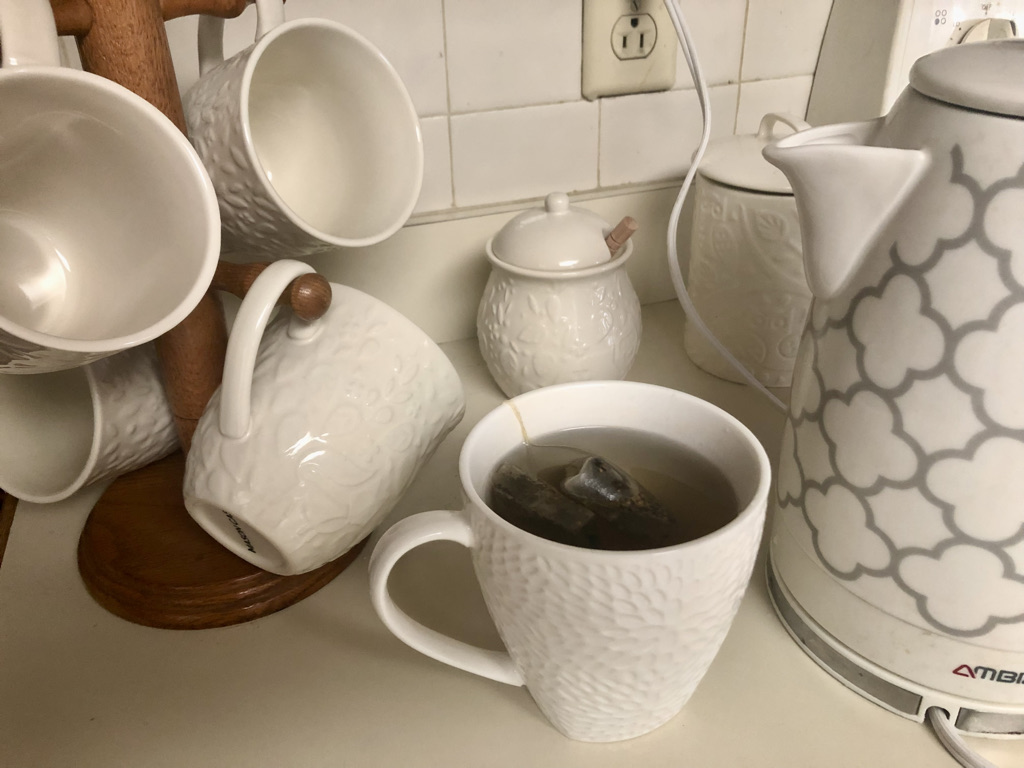
After reading Howell and Reinhard’s book, I have learned to differentiate between the two in these ways:
Routine: Routines are actionable, orderly steps that occur regularly.
Ritual: Rituals are routines that we have thoughtfully designed to bring deeper meaning to the action.
The authors Identify 3 key elements of a ritual: intentionality, individualization, and tools/techniques.
When I make tea, I visit a carefully arranged spot in my kitchen. It holds a ceramic electric tea kettle and beautiful mugs that I have thoughtfully selected and enjoy using. The cupboard above is stocked with my two favorite teas, cinnamon and licorice. A little honey pot sits on the counter so I can add some sweetness. I make my tea at the same time every day, and when I am teaching, I enjoy my first sips during morning meeting with my students.
Alternatively, I eat breakfast every day, but it might be yogurt (no special brand), or a granola bar that I grab on the way out the door and eat on the ride to school.
Can you see the difference? Which one is the routine and which one is the ritual? Can you envision how the breakfast example might become a “ritual,” if I was more intentional about it?
We can build connection between ourselves and our students and nourish those relationships using classroom rituals. In this 3-part series, I share ways to transform your daily, monthly, and seasonal kindergarten routines into classroom rituals.
From Daily Kindergarten Routines to Rituals
There are “bookends” around our day that contain many kindergarten routines that can easily be transformed into rituals by adding intentionality, individualization, and tools. These include arrival and dismissal tasks as well as opening and closing meetings. Here is a list of some ways that I have welcomed and closed the day in my own classroom over the years.
Opening Routines
Door Greeting: I stand in a familiar spot when the children arrive, where I am able to greet each child by name and let them choose the way in which they choose to return the greeting: hug, handshake, high-five, pinky hug, heart hand, or fist bump. There are 11 choices in all, but I only put a few out each day so they can enjoy trying out different ones.
Gathering Song: Over the years, I’ve tried playing soft background music as children arrive as well as a specific gathering song to sing them into the day. My favorites are See Me Beautiful and I Think You’re Wonderful by Red Grammar or you might choose a good morning song such as Good Morning by Greg and Steve.
Lighting the Day: I keep a small lamp on a bookshelf that I switch on each morning and it’s a visual reminder to look for the light within each child. The children and I also pretend to strike a match and light a plush “campfire” that we gather around for morning meeting.

Opening Chime: I signal the start of the day using a Tibetan chime and say, “Listen for the place where the sound ends and the silence begins.” You might also use a rain stick, wind chime, or bell chime.
Class Motto and Promises: Each morning a child is chosen (see spotlight child) to lead the class in reciting our class motto and promises. We hold up our promise sign and say the words together.
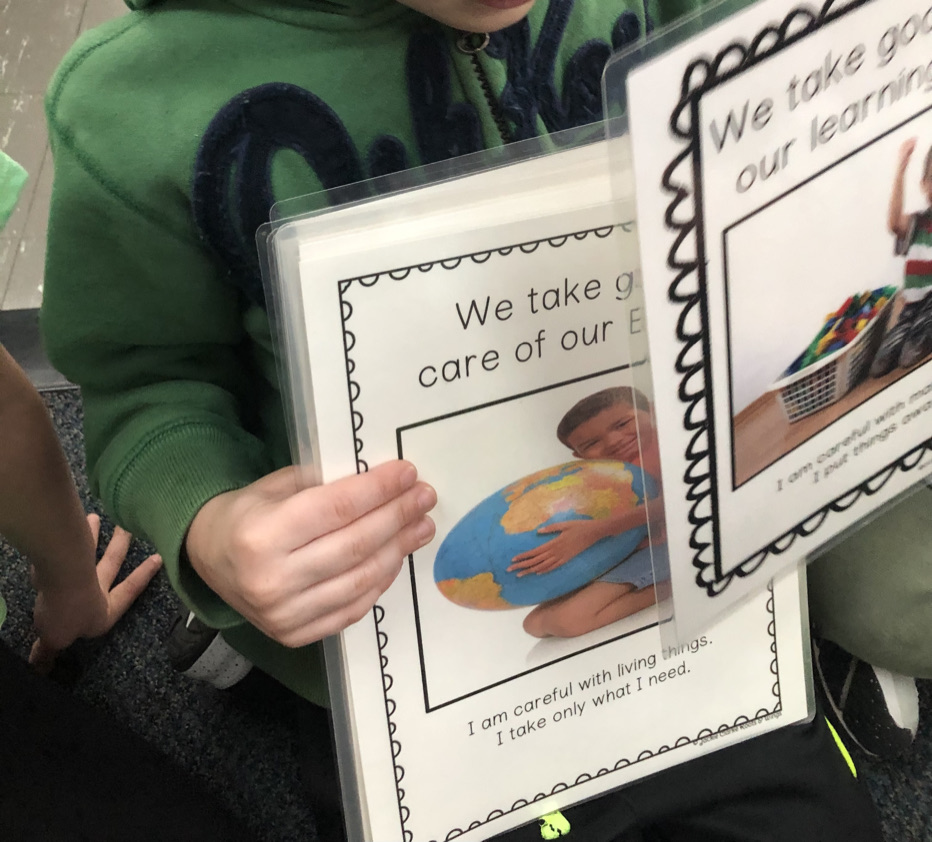
Wish You Well Board: Once I’ve taken attendance, we place the name tags of absent students on a heart-shaped board and sing this song to the tune of Where is Thumbkin?:
Where is Brayden, Where is Brayden?
He’s not here. He’s not here.
We hope he’s here tomorrow, hope he’s here tomorrow.
We miss him. We miss him.
This daily ritual helps children know that when they are not in school, we are still thinking of them.
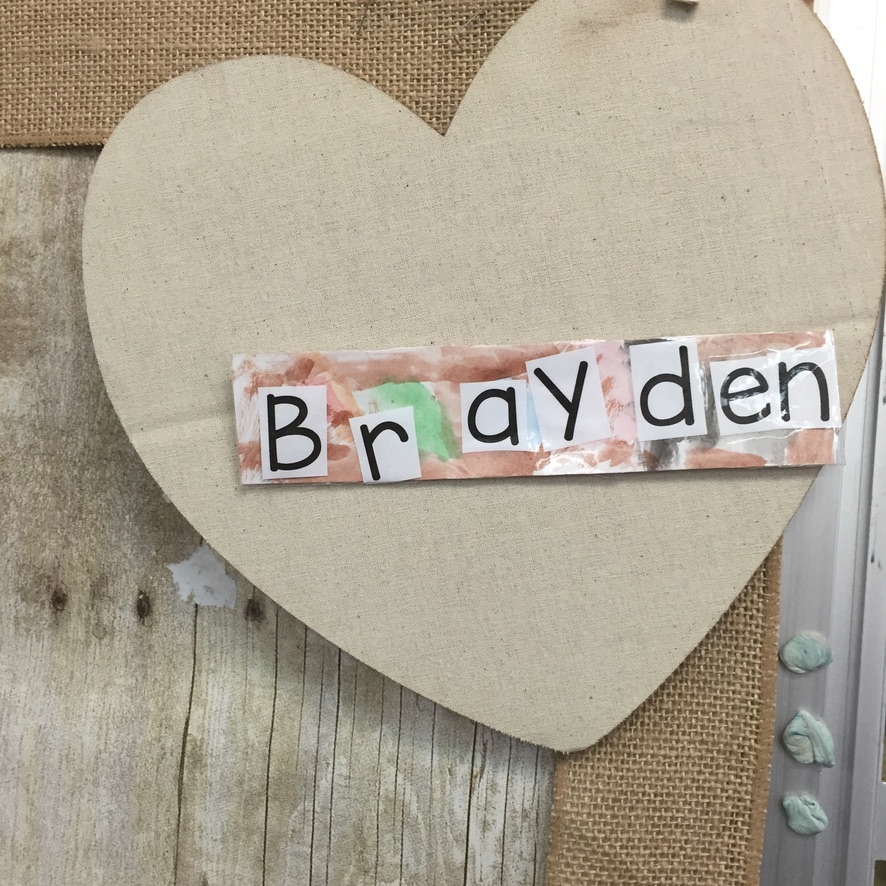
Daily Plan Review: I review the daily plan to let children know what we will be doing that day and in which order. This is so important for those children who struggle with anxiety – knowing what is happening when helps to ease their worries. And all children use this throughout the day to answer their own questions about where we are in our day and when lunch is coming.
Feelings Check-In: At the beginning of the year, I introduce Generation Mindful’s feeling zones (similar to Zones of Regulation). We spend a lot of time learning about our feelings and identifying the “feeling zone,” for characters that we encounter in our books. This allows us to do a feelings check-in where we share which zone we are in and why, if we are comfortable doing so.
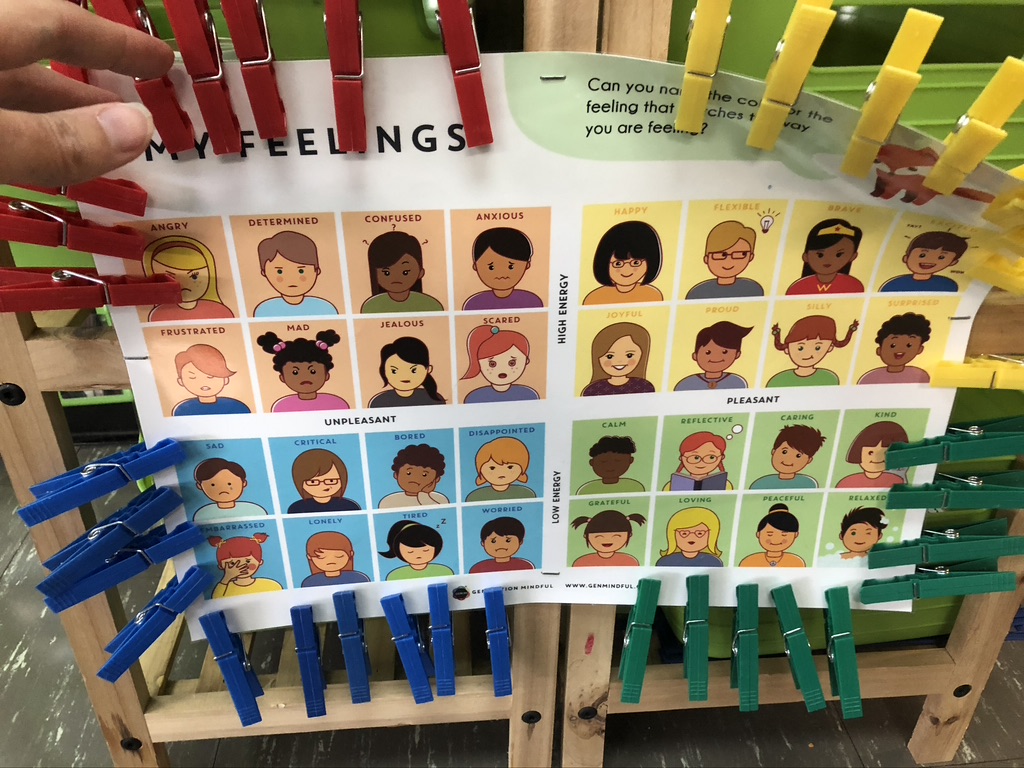
News Share: We take turns answering the question, “What’s the News?” and sharing one thing that is happening in our lives, often outside of school. At the end, children can raise their hands to ask questions if they want to know more about someone’s news.
Mascot Check-in: Sometimes it’s been a stuffed animal, other times a puppet, but I usually have a plush friend of some sort that becomes part of our classroom community. Each morning, we check-in with our friend to see if he/she has something to share. It might be a worry he/she is having that kids can help with or maybe he/she is holding an object that relates to something we will be learning or doing during the school day.

Spotlight Child: We use a Name Game routine, where children guess the letters in a child’s name to reveal the “spotlight child” of the day. This child is the one that is my helper, gets special privileges such as leading activities or choosing a song, and is the one that I am carefully observing and taking notes on that day.
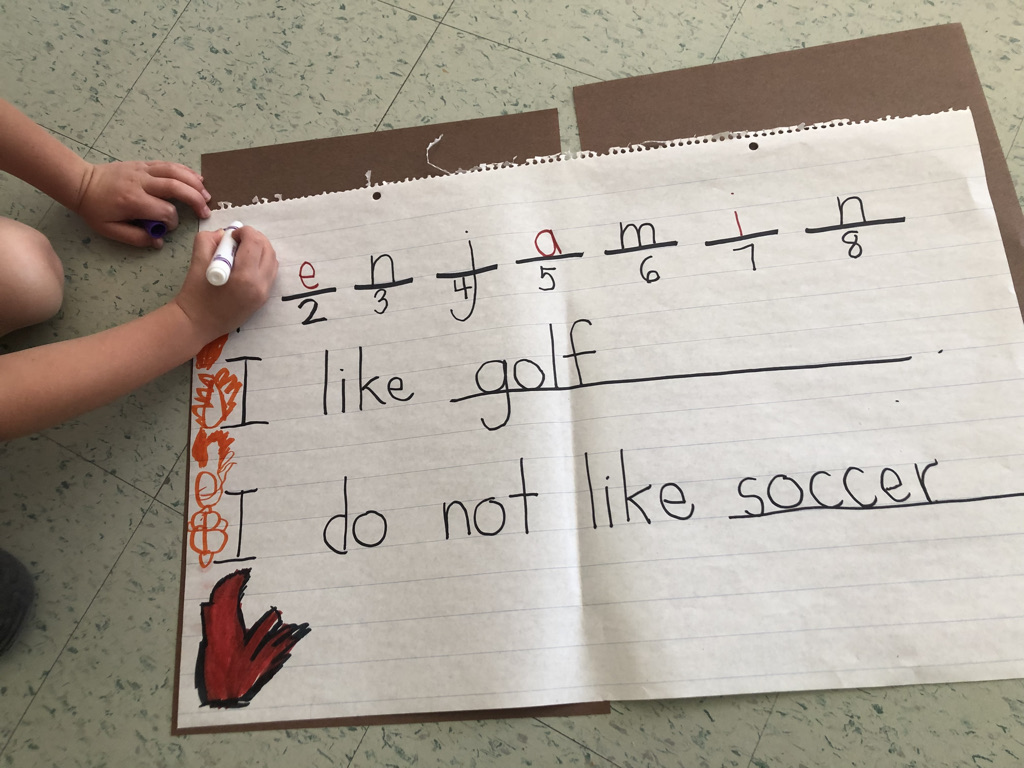
Mindful Moments: We end our morning meeting with Kyra Wiley’s Mindful Moments that offer, not only a pause in our day, but strategies that teach us how to bring our bodies down from the “red zone” to the “green zone,” which is always best for learning.
Closing Routines
Closing Song: Similar to the idea of a gathering song, we end the day with a closing song. My favorite is Together Tomorrow Again by Tom Chapin. We hold hold hands in our circle and sway back and forth as we listen to this song and I usually dismiss small groups of children to leave our circle to get ready to go home.
Daily Reflection: Just as we reviewed the daily plan in the morning, we return to it at the end of the day to reflect on our time together. I flip the schedule cards back over, and as I do, I invite them to visualize each part of that time we had together. Children can then share what they remember most about the day, their favorite activity, or even the trickiest part.
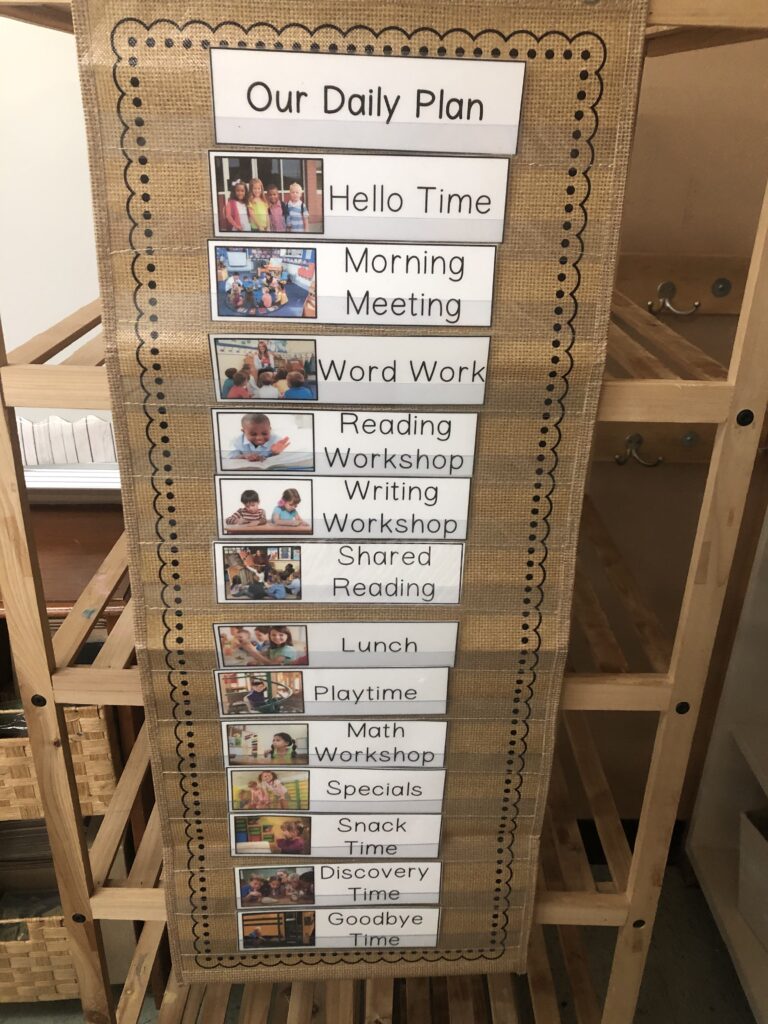
Looking Ahead: I give kids a quick preview of what we will be doing tomorrow to remind them of special events, things that are due, or items they might need to bring or wear. This is just as helpful for them as it is for me as I close out one day and begin to think about what I need to do for the next.
Goodbye Words: This is something I have not yet done, but would like to add to our closing routines next year. Just as TV programs have a “sign off” that viewers hear at the end of every show, I would like to choose some “send off” words that children can take with them as they leave for the day. This might be our motto (be your best) or “Peace out,” or something playful such as “See you later alligator.” Either way, the kids will come to expect these “goodbye words” at the end of each day.
Door Greeting: Just as each child chooses how to greet you each morning, they can choose the way in which they want to say goodbye. That’s an already-established ritual that you can use to both open and close the day.
Create Your Own Daily Rituals
Use the above list to get you started thinking about which daily rituals you want to create for your own community of learners. And be on the lookout for them to show up organically as you move through the year with your kids.
One year, our closing song was Little Willy by a 70’s band called Sweet. A little girl’s dad used to play it for her and she asked if I knew it. On a whim, I played it one day and the kids kept asking to hear it again and again. It ended up being our goodbye song that year and we would end each day singing, “Little Willy, Willy won’t go home.” That ritual came and went with that group of kids because it just didn’t make sense for the next group. But that class and I will always have Little Willy.
If you are not sure where to start, begin by listing all of your opening and closing kindergarten routines. Then, ask yourself these questions:
- How can I be more intentional about how this routine is carried out?
- How can I individualize it with something that is meaningful to me or our class?
- Are there tools or materials that I could use to make it more meaningful, fun, or playful?
Not all your kindergarten routines need to become rituals, just choose a few to tweak a bit to up the connectivity factor in your classroom. And you might find that your “class” begins to feel more like a “family.”
For help on creating your own classroom routines/rituals, download this free Routines and Rituals Toolkit and check out the Growing Traditions page in the Roots & Wings Resource Library.
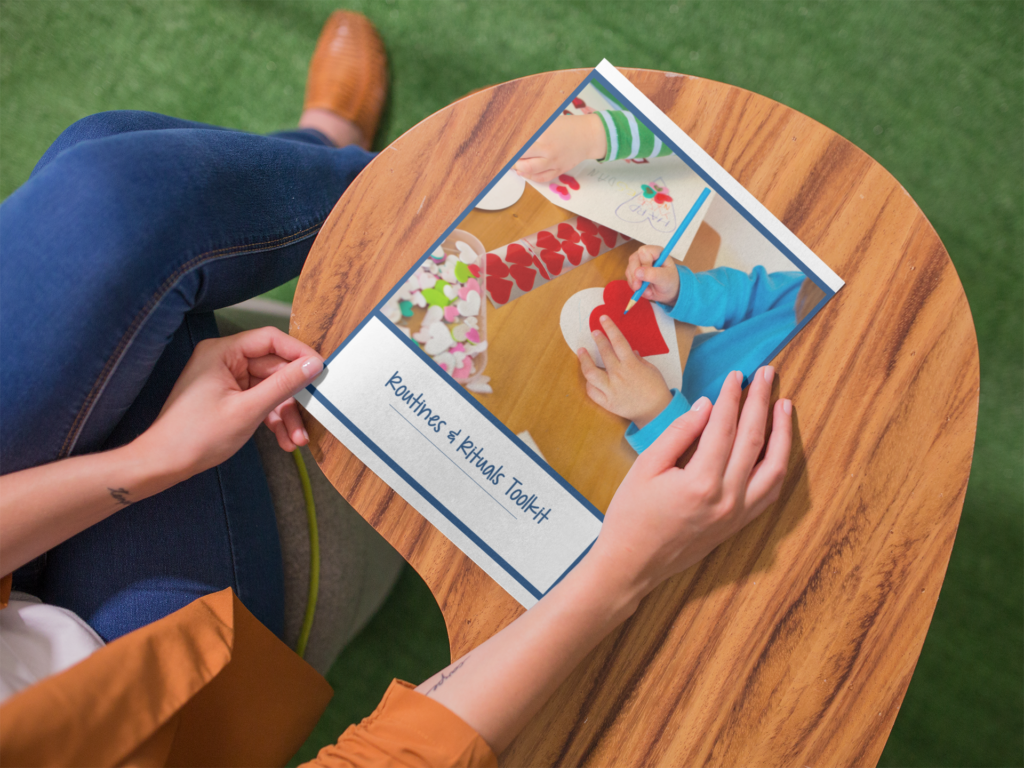
This post contains affiliate links. Roots & Wings is a participant in the Amazon Services LLC Associates Program, an affiliate advertising program designed to provide a means for sites to earn advertising fees by advertising and linking to Amazon.com.


 Routines & Rituals to Welcome the Season
Routines & Rituals to Welcome the Season The 100th Day of School: How it All Began
The 100th Day of School: How it All Began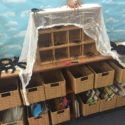 Center Transformations for Your Classroom Halloween Party
Center Transformations for Your Classroom Halloween Party Kindergarten Bunny Brunch
Kindergarten Bunny Brunch
This is really awesome insight….. I really appreciate your website and everything you are striving for with your students….
Hi Kathryn!
Thank you so much for your comment – glad you found this post helpful!
Hi LOVE all of this so much!
What font did you use for the spotlight student names? Was it a boxed in font or did they just cut the letters apart?
THANKS!
Hi Cindy! I’m thinking you might be asking about the name cards the kid’s make – it wasn’t a boxed in font, I just spaced the letters apart, cut them up, and put them in an envelope for each child. Then, they order them and glue them on the name card.